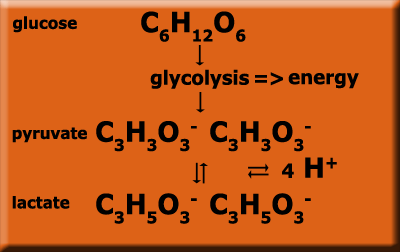Question - What is Lactate and associated metabolites?
- What is Lactate?
- Lactate is an organic molecule. In past versions of this page we have said it was a carbohydrate. It is technically not a carbohydrate, but an ion with a negative charge, or an anion. Its chemical formula is C3H5O3. It is found in every cell in the body; it is on the skin and in sweat and saliva. It is harmless.
- What is Lactic Acid?
- Lactic acid is an organic molecule. Its chemical formula is C3H6O3 Lactic acid has the same proportion of carbon, hydrogen and oxygen as carbohydrates but it is technically not a carbohydrate. It is rarely found in the body. It is harmless. Many people believe wrongly that lactic acid occurs in the muscles after hard exercise, causing a burning sensation. This is not true. Actually, if lactic acid is produced in the body, it breaks down almost immediately into lactate and hydrogen ions. What persists in the body is lactate. Notice the chemical formulas are very similar. A very kindly and professional chemist suggested some of the wording in these definitions.
- Does lactate or lactic acid have anything to do with breast milk or lactation? What about lactose intolerance?
- No. Lactic acid was discovered in sour milk in the late 1700's. Because it was discovered in milk, it was given the name lactic acid. But that is it. There is no connection to lactation or lactose intolerance or a type of milk called Lactaid.
Return to Questions Page
- What is glucose?
- Glucose is a simple sugar (monosaccharide) and an important carbohydrate in both animal and plant metabolism. Its chemical formula is C6H12O6. Cells use glucose as a source of energy and a metabolic intermediate. Glucose is one of the main products of photosynthesis and starts cellular respiration (this first part was taken from Wikipedia.) Now look at the chemical formula and the one for lactic acid. Glucose is exactly double. This relationship is why lactate is important. Glucose is one of the main fuels in our bodies for energy and when it is broken down it ends up as two lactates. For those of you who are chemistry wiz's, you know we skipped something and we will now get to it.
- What is glycogen?
- Glycogen is just a string of glucose molecules. So if you hear the term that someone is glycogen-depleted or low on glycogen it just means that there is little glucose in their muscles. If there is little glycogen in the muscles then glucose cannot break down to form lactate and this form of energy production is cut off.
- What is pyruvate?
- Pyruvate is an organic molecule used for energy. Its chemical formula is C3H3O3- and sometimes appears as pyruvic acid C3H4O3. It is found in every cell in the body, but in much smaller quantities than lactate. It seldom persists and is either converted into lactate or used for energy. Notice that the pyruvate chemical formula is similar to the formula for lactate.
It differs by two hydrogen ions.
Return to Questions Page
- Do you have to know chemistry to use lactate testing?
- No, we showed the chemical formulas to demonstrate that these molecules are all related. All the coach or athlete has to know is that lactate, glucose, pyruvate and glycogen are changed during exercise and that they turn back and forth into each other. Actually lactic acid is not part of anything but a high percentage of the coaches and athletes think it is. Many will refer to a lactic acid threshold instead of a lactate threshold. Actually, there is no such thing as a lactic acid threshold. To understand all this better go over the energy generating processes on our CD-ROM or a briefer version in our basic energy discussion in our triathlon section.
- Where does lactate come from?
- Glucose is used to produce energy. The process does not use any oxygen. Thus, the process is call anaerobic or not aerobic because it does not use air or oxygen. This anaerobic process has a name which is glycolysis. Remember glycogen from above. That supplies the "glyco" part and "lysis" is just the suffix from the Greek which means to break down as in analysis or catalysis or paralysis or dialysis. Well glycolysis breaks down glucose and produces energy and lactate. It really produces 2 pyruvates but the 2 pyruvate immediately turns into 2 lactates. An important part is that this process does not need oxygen and is called anaerobic. For those who don't mind chemistry here is the process that produces lactate.

- Are there other anaerobic processes that produce energy?
- Yes, another important process is the creatine phosphate process and there are other minor ones. See the link above to the basic energy discussion.
Return to Questions Page

